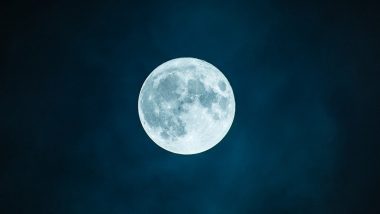London, August 14: Scientists have discovered the first definitive proof that the Moon inherited indigenous noble gases of helium and neon from the Earth's mantle. The discovery, published in the journal Science Advances, adds to the already strong constraints on the currently favoured "Giant Impact" theory that hypothesises the Moon was formed by a massive collision between Earth and another celestial body.
It also represents a significant piece of the puzzle towards understanding how the Moon and, potentially, the Earth and other celestial bodies were formed. For the study, the team ETH Zurich analysed six samples of lunar meteorites from an Antarctic collection, obtained from NASA. The meteorites consist of basalt rock that formed when magma welled up from the interior of the Moon and cooled quickly. Ice Deposits Reported in Moon's South Pole May Have More Than One Source, Says Study.
They remained covered by additional basalt layers after their formation, which protected the rock from cosmic rays and, particularly, the solar wind. The cooling process resulted in the formation of lunar glass particles amongst the other minerals found in magma.
The team discovered that the glass particles retain the chemical fingerprints (isotopic signatures) of the solar gases: helium and neon from the Moon's interior. Their findings strongly support that the Moon inherited noble gases indigenous to the Earth.
"Finding solar gases, for the first time, in basaltic materials from the Moon that are unrelated to any exposure on the lunar surface was such an exciting result," said Patrizia Will from ETH Zurich.
Without the protection of an atmosphere, asteroids continually pelt the Moon's surface. It likely took a high-energy impact to eject the meteorites from the middle layers of the lava flow similar to the vast plains known as the Lunar Mare.
Eventually the rock fragments made their way to Earth in the form of meteorites. Many of these meteorite samples are picked up in the deserts of North Africa or in, in this case, the "cold desert" of Antarctica where they are easier to spot in the landscape. Knowing where to look inside NASA's vast collection of some 70,000 approved meteorites represents a major step forward.
"I am strongly convinced that there will be a race to study heavy noble gases and isotopes in meteoritic materials," said ETH Zurich Professor Henner Busemann. He anticipates that soon researchers will be looking for noble gases such as xenon and krypton which are more challenging to identify. They will also be searching for other volatile elements such as hydrogen or halogens in the lunar meteorites.
"While such gases are not necessary for life, it would be interesting to know how some of these noble gases survived the brutal and violent formation of the moon. Such knowledge might help scientists in geochemistry and geophysics to create new models that show more generally how such most volatile elements can survive planet formation, in our solar system and beyond," Busemann said.
(The above story first appeared on LatestLY on Aug 14, 2022 07:29 PM IST. For more news and updates on politics, world, sports, entertainment and lifestyle, log on to our website latestly.com).













 Quickly
Quickly











